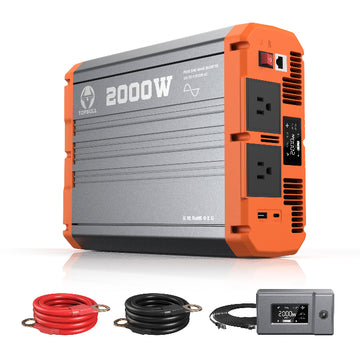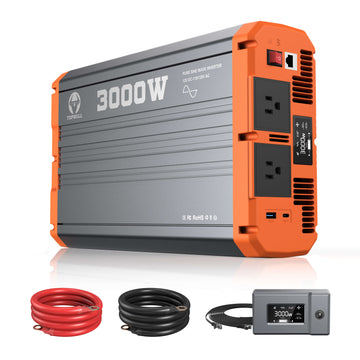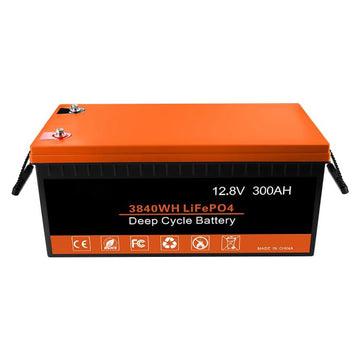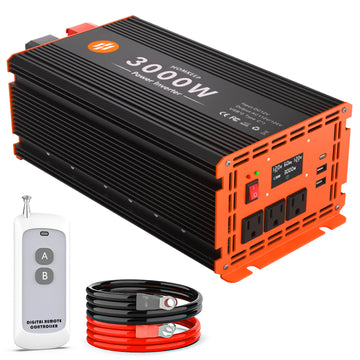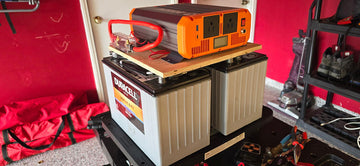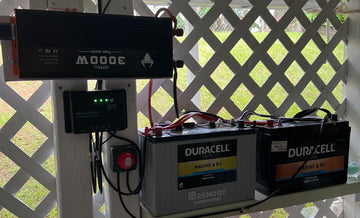For many families and outdoor adventurers, installing a solar power system with battery storage has become an excellent way to solve their energy needs. And one of the most common questions when assembling a solar system is what is the size of the solar panel that charges the 12V battery? How fast do solar panels charge? Therefore, understanding how to choose the right solar panel to charge a 12V battery becomes a more important part of DIY solar. This article will delve deeper into this topic, from battery type, charging principles to specific choices, to help you quickly find the best solar battery charging solution for your needs.
The difference between 12V battery and 24V, 36V, 48V battery
12V Batteries: as one of the most common battery voltages, 12V batteries have a broad base of applications in electrical systems. Its voltage is stable and suitable for use in small equipment and vehicle power systems. However, when using high-powered appliances, 12V systems may generate high currents, causing wires to heat up. Due to its wide compatibility and low cost, 12V batteries are widely used in automobiles, motorbikes, small appliances and other equipment. Its stability and ease of maintenance make it the preferred power source for many devices.
24V Batteries: Compared to 12V batteries, 24V batteries deliver the same power at a lower current, which helps to reduce heat and energy loss in the wires. As a result, 24V batteries may be more advantageous in some applications that require high power output. In industrial and commercial applications, 24V batteries are favoured for their high voltage and low current characteristics. It is commonly used in heavy equipment, trucks, ships and other applications that require high power output.
36V battery: 36V battery belongs to the medium voltage class, its output voltage is higher, which can meet the use of some equipment with higher voltage requirements. In the field of power tools, electric vehicles, etc., 36V batteries are widely used.
48V battery: 48V batteries are higher in voltage, suitable for occasions requiring higher voltage and power output. With the rise of electric and hybrid vehicles, 48V batteries are gradually becoming the preferred power source for these vehicles. Their high voltage, high energy density and fast charging characteristics enable vehicles to have longer range and faster charging speeds.
12V battery is the most common backup power
If there are portable devices in the family or the need for back-up power supply, usually choose to have some 12V lithium batteries or lead-acid batteries as a back-up power supply, this is due to the high popularity of 12V batteries in the market, and widely used in small electrical appliances and vehicles, these batteries can be used for emergency lighting, small power tools, car refrigerators and other equipment.
For outdoor explorers, outdoor explorers usually carry a variety of electronic devices such as cameras, GPS locators, torches, etc., so it is crucial to choose batteries that are lightweight and easy to carry. In this case, 12V or 24V portable lithium batteries may be a good choice because they have high energy density and relatively small size.
Types of 12V batteries: lithium batteries, lead acid batteries, deep cycle batteries
Lithium Batteries: 12V lithium batteries stand out for their high energy density, long life and environmentally friendly characteristics. They are suitable for devices that require portable, high-efficiency power supply, such as electric vehicles, portable electronic devices and energy storage systems. Lithium batteries have no memory effect and can be charged and discharged at any time, bringing convenience to users.
Lead-acid batteries: As a traditional and relatively low-cost battery type, 12V lead-acid batteries are widely used in areas such as car starting, UPS power supply and solar energy storage due to their high capacity and stability. Although their energy density is not as high as lithium batteries, they perform well in large capacity energy storage needs.
Deep Cycle Battery: 12V deep cycle batteries are designed for deep discharge and frequent charging and discharging, with high cycle life and excellent capacity retention. They are particularly suitable for scenarios such as solar energy storage, backup power for communication base stations, and transport vehicles that need to run for long periods of time, ensuring reliable and long-lasting power support in these applications.
How to charge a 12V battery with a solar panel
When charging a 12V battery with solar panels, you first need to ensure that the output voltage of the solar panel is slightly higher than the charging demand of the battery, which is usually achieved by selecting a panel with the appropriate maximum power point voltage (Vmpp). Next, in order to maximise the energy conversion efficiency, a maximum power point tracking (MPPT) controller is recommended, which automatically adjusts the charging parameters according to the output characteristics of the solar panel to ensure that the battery is charged with optimal efficiency under all lighting conditions.
Through the MPPT controller, a safe and efficient charging connection is established between the solar panel and the 12V battery, which effectively prevents overcharging and over-discharging problems. During the whole charging process, the charging status and performance of the battery should be monitored regularly to ensure stable system operation. It is also necessary to consider the impact of weather factors on the output power of the solar panel and take appropriate measures to cope with unfavourable conditions such as insufficient light or cloudy or rainy weather, so as to ensure the reliability and durability of the charging system.
What affects the speed at which solar panels charge 12V batteries
The speed at which a solar panel charges a 12V battery is affected by several factors, including the following:
1. The output power of the solar panel
- Power level: the higher the power of the panel, the more power it produces, thus increasing the charging speed. For example, a 100W solar panel can usually charge faster than a 50W panel.
- Efficiency: Different types and brands of solar panels have different efficiencies under light conditions, the higher the efficiency, the faster the charging speed.
2. Light conditions
- Intensity of sunlight: The intensity of sunlight directly affects the output power of the panels. Charging efficiency is highest on sunny days, while charging speed decreases dramatically on cloudy or overcast days.
- Duration of sunlight: The amount of sunlight available during the day (usually a few hours) also affects the total charging time.
- Seasonal variations: Different seasons will affect the light intensity due to variations in the angle and duration of sunlight exposure.
3. Tilt angle and orientation
- Mounting angle: The tilt angle and orientation of the solar panel will affect the efficiency of light reception. The best angle is usually at midday to maximise sunlight capture.
- Shade Shading: If the panel is shaded by trees, buildings or other objects, it will result in less efficient charging.
4. Battery Status
- Battery capacity: The capacity of the battery (e.g. 12V 100Ah) affects the charging time, the higher the capacity, the longer the charging time.
- Battery charging status: If the battery is full, charging will stop. If the battery is low, charging will be faster.
- Battery type: different types of batteries (lead-acid, lithium batteries, etc.) have different current and voltage requirements and acceptance speeds when charging, which affects charging efficiency.
5. Charge controller
- Charge Controller Efficiency: The type and efficiency of the charge controller will affect the speed of battery charging. An efficient controller can better regulate the current and maximise the use of solar energy.
- Charging mode: Different charging modes (e.g. float, absorption, equalisation charging, etc.) will affect the charging speed.
6. Temperature
- Ambient temperature: Extreme high or low temperatures can affect the efficiency of solar panels and their components.
A combination of the above factors can better optimise the speed at which solar panels can charge 12V batteries. Choosing the right equipment, proper installation and proper maintenance are all key to improving charging efficiency.
How much time does it take for a 200w solar panel to charge a 12v battery
To calculate the time it takes for a 200W solar panel to charge a 12v battery, here are some key factors and calculation steps:
1.Determine the battery capacity
Firstly, you need to know the capacity (in Ah) of the 12V battery you want to charge. For example, if the battery capacity is 100Ah.
2. Calculate the energy required for charging
Energy (Wh) = Battery capacity (Ah) x Voltage (V)
For a 100Ah battery:
Energy = 100Ah x 12V = 1200Wh
In this way, you can determine that the energy requirements needed to fill a 100Ah 12V battery
3、Consider the charging efficiency
Charging efficiency is usually between 70% and 90%. Suppose the charging efficiency is 80%:
Actual energy requirement = Energy/charging efficiency = 1200Wh/0.8=1500Wh
4. Calculate charging time
Charging time (hours) = actual energy demand (Wh) / solar panel power (W)
For a 200W panel:
Charging time = 1500wh/200w = 7.5 hours
So, how much time is needed to charge a 12v battery with 200w solar panel, first of all, we should determine the capacity of the battery, the larger the capacity represents the more energy required, the longer the charging time, charging a 100Ah 12v battery with a 200W solar panel, theoretically it takes about 7.5 hours, the actual time may be different due to the light conditions, charging efficiency and other factors.
What size of solar panel can charge a 12V battery
What size solar panel can charge a 12V battery is not a fixed value, but depends on the output voltage and power of the solar panel as well as the actual demand.
Firstly, the output voltage of the solar panel must be within a certain range to ensure that it can effectively charge a 12V battery. Typically, the solar panel voltage to charge a 12V battery should be between 15-20V, which is based on the charging characteristics of the battery and the output characteristics of the solar panel. Such a voltage range ensures that the battery can receive the charging current safely and efficiently.
Secondly, the power of the solar panel is also an important factor. The more power a solar panel has, the more current it can generate under the same light conditions, which allows it to charge the battery faster. However, this does not necessarily mean that the more powerful the solar panel is, the better it is, as factors such as cost, installation space and practical needs also need to be considered.
Based on the wattage of the solar panels, and the hourly production (peak insolation), we can roughly estimate the time required for different power solar panels (50w, 100w, 200w, 300w, 500w, and 1000w) to charge 50Ah and 100Ah 12V batteries, where the charging efficiency is preset to 80%:
|
Solar panel power |
Output per hour (peak sunlight) |
Time required to charge a 50Ah 12V battery |
Time required to charge a 100Ah 12V battery |
|
50W |
50W |
Approx. 15 hours |
Approx. 30 hours |
|
100W |
100W |
Approx. 7.5 hours |
Approx. 15 hours |
|
200W |
200W |
Approx. 3.75 hours |
Approx. 7.5 hours |
|
300W |
300W |
Approx. 2.5 hours |
Approx. 5 hours |
|
400w |
400W |
Approx. 1.88 hours |
Approx. 3.75 hours |
|
500W |
500W |
Approx. 1.5 hours |
Approx. 3 hours |
|
800W |
800W |
Approx. 0.94 hours |
Approx. 1.88 hours |
|
1000W |
1000W |
Approx. 0.75 hours |
Approx. 1.5 hours |
The above table shows the time required to charge batteries of different capacities using solar panels of different wattages. By choosing the right solar panel wattage, you can effectively reduce the charging time.
Best Solar Panel for Charging 12V Batteries
When choosing the best solar panel for charging 12V batteries, you should consider the capacity of the battery, the power of the solar panel and its conversion efficiency. The ideal solar panel should have the right wattage to ensure fast charging in full sunlight. In addition, choosing a panel with a high conversion efficiency will enhance charging, thus extending the life of the battery.
High Efficiency 12V 100 Watts Monocrystalline Solar Panel Module

This 12V 100 Watts Monocrystalline Solar Panel is highly sought after for its high energy conversion rate and stable performance. It utilises advanced monocrystalline technology to produce a stable 12 volts and up to 100 watts of power output in sunny environments. Whether it's for a home photovoltaic power system, outdoor camping equipment, or as an emergency backup power source, this solar panel provides you with a reliable and environmentally friendly energy solution that's perfect for charging 12V batteries.
FAQ about charging 12V batteries
How long does it take a 20W solar panel to charge a 12V battery
A 50Ah 12V battery has a total energy of 600Wh (12V x 50Ah). Under ideal conditions, a 20W solar panel will provide 20Wh per hour, so it will take about 30 hours to fully charge the battery
How many panels do I need to charge a 12V 200Ah battery
The total energy of a 200Ah 12V battery is 2400Wh (12V x 200Ah). With a 100W solar panel, each panel provides 100Wh per hour and it takes 24 hours to fully charge the battery. If you wish to reduce the charging time in the same time, you can use more than one panel. For example, using 2 x 100W panels will fill the battery in 12 hours!
What are the best conditions for charging the battery
Optimal charging conditions include plenty of direct sunlight, the right temperature (usually between 20°C and 25°C), and the right battery management system to prevent overcharging or over-discharging.
Do lithium batteries charge faster than lead-acid batteries? Is it safe?
Lithium batteries typically charge faster than lead-acid batteries due to their higher charging efficiency and lower internal resistance. In terms of safety, lithium batteries are safe when used and managed correctly, but care needs to be taken to prevent overcharging, over-discharging and high temperatures.

